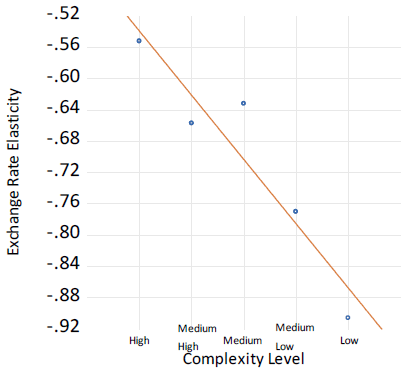| Author Name | Willem THORBECKE (Senior Fellow, RIETI) / CHEN Chen (Xi'an Jiaotong-Liverpool University. Suzhou) / Nimesh SALIKE (Xi'an Jiaotong-Liverpool University. Suzhou) |
|---|---|
| Download / Links |
This Non Technical Summary does not constitute part of the above-captioned Discussion Paper but has been prepared for the purpose of providing a bold outline of the paper, based on findings from the analysis for the paper and focusing primarily on their implications for policy. For details of the analysis, read the captioned Discussion Paper. Views expressed in this Non Technical Summary are solely those of the individual author(s), and do not necessarily represent the views of the Research Institute of Economy, Trade and Industry (RIETI).
China faces tariffs, trade wars, volatile exchange rates, and other challenges. How can Chinese firms sustain their exports in the face of these shocks? Abiad et al. (2018) and Asian Development Bank (2018) noted that products with lower demand elasticities will be less affected by impediments to trade. They also observed that goods that are complex (in the sense of Hausmann and Hidalgo, 2009) are difficult to produce. Thus purchasers need time and effort to find substitutes for these goods. Since finding substitutes is difficult, microeconomic theory indicates that complex goods should have lower price elasticities. Simple goods, on the other hand, are like commodities and are more substitutable. Theory thus implies that they should have larger elasticities.
Hidalgo and Hausmann (2009) employed the method of reflections to measure the complexities of economies and products. For an economy, they measured complexity by its diversification. They defined diversification as the number of products that a country exports with revealed comparative advantage (RCA) greater than one. For a product, they measured complexity by its ubiquity. They defined ubiquity as the number of countries that export the product with RCA greater than one. Intuitively, an economy that exports more products with RCA greater than one is more diversified and a product that fewer countries export with RCA greater than one is less ubiquitous. Higher diversification implies that an economy has more capabilities and lower ubiquity implies that the product requires more capabilities to produce. For instance, in the chemical industry many countries produce ammonia. This product is thus classified as ubiquitous. On the other hand, Japan produces 90% of the world's fluorinated polyimide and 70% of its etching gas (Obayashi, 2019). These goods are thus classified as complex.
We estimate elasticities for China's exports of 960 manufactured goods to 190 countries over the 1995-2018 period and investigate whether there is a relationship between products' exchange rate elasticities and their Product Complexity Indices (PCI) calculated using the method of Hausmann and Hidalgo (2009). To do this we use the PCI values for the 960 products to classify them into five sophistication categories: high, medium high, medium, medium low, and low complexity goods.
In our preferred specification, we find that for the most sophisticated exports a 10 percent renminbi appreciation is associated with a 5.5 percent drop in exports. We also find that for the least sophisticated exports, a 10 percent appreciation of the renminbi is associated with a 9.1 percent drop in exports. Thus these findings indicate that sophisticated exports such as lubricants, zirconium, and titanium are less sensitive to exchange rates than unsophisticated exports such as natural rubber, sulphur, and prepared fish.
To understand how the elasticities vary by sophistication level, Figure 1 plots the exchange rate elasticities across sophistication levels. The figure indicates that the exchange rate response is lowest for the most sophisticated category. There is no statistical difference between the response for medium high and medium sophisticated products. The response is larger again for medium low sophisticated products and largest for low sophisticated goods. The elasticities in Figure 1 indicate that less sophisticated exports fall more than more sophisticated products when the renminbi appreciates. The paper reports similar findings using several other specifications.
The important implication of these findings is that more sophisticated exports from China are less sensitive to exchange rates. This indicates that technological upgrading can help China to maintain stability in the volume of its exports.

- Reference(s)
-
- Abiad, A., Baris, K., Bertulfo, D., Camingue-Romance, S., Feliciano, P., Mariasingham, J., Mercer-Blackman, V., & Bernabe, J. (2018). The impact of trade conflict on developing Asia. (Working Paper No. 566). Manila: Asian Development Bank.
- Asian Development Bank. (2018). Asian Development Outlook Update. Manila: Asian Development Bank.
- Hidalgo, C. A., & Hausmann, R. (2009). The building blocks of economic complexity. Proceedings of the National Academy of Sciences, 106, 10570–10575.
- Obayashi, Y. (2019). Japan to tighten export rules for high-tech materials to South Korea. Reuters, 30 June.

